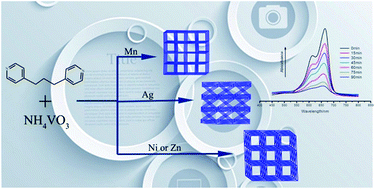POM-based inorganic–organic hybrid compounds: synthesis, structures, highly-connected topologies and photodegradation of organic dyes†
Abstract
Four new polyoxovanadate-based organic–inorganic hybrid materials [MnV2(bpp)2O6] (1), [Ag4V4(bpp)4O12]·2H2O (2) and [M3V6(bpp)4O18·4H2O]·2H2O [M = Ni (3), Zn (4), bpp = 1,3-bis(4-pyridyl)propane] have been synthesized under hydrothermal conditions through the self-assembly of transition metal salts, bpp ligands and ammonium metavanadate. Single-crystal X-ray diffraction analyses show that 1 possesses a three-dimensional framework, constructed from arrays of {V4O12} rings covalently linked through metal–organic units, {Mn(C13H4N2)2}. Compound 2 is an eight-connected self-catenated metal–organic framework, based on bimetallic {Ag4V4O12} clusters as nodes. Compounds 3 and 4 are isostructural, both of them exhibit an intriguing 6,10-connected network. The structure of 4, as an example, is based on single zinc atoms as six-connected nodes, as well as bimetallic {Zn2V6O18} clusters as ten-connected nodes, defining not only a new topology for three-periodic nets but also the first 6,10-connected framework using heterometallic clusters as nodes. Furthermore, the thermal stabilities and photocatalytic activities of 1–4 have been discussed in detail.


 Please wait while we load your content...
Please wait while we load your content...